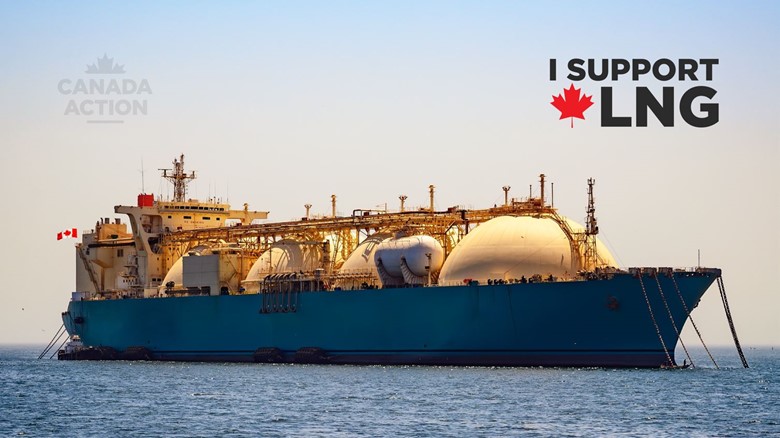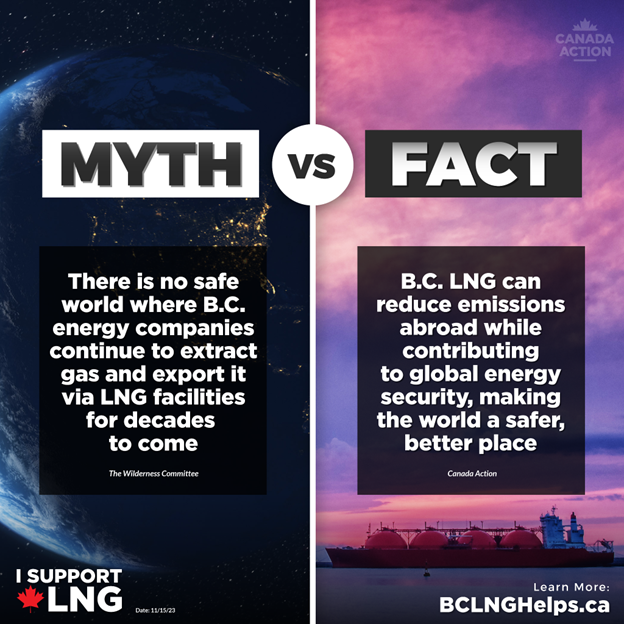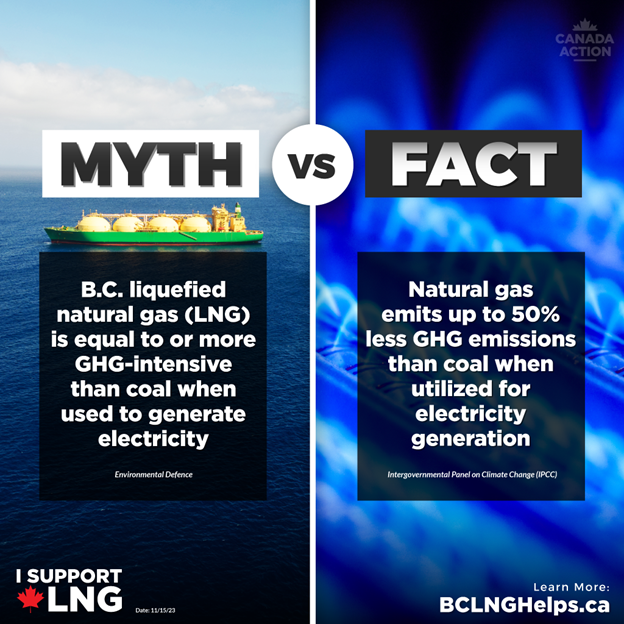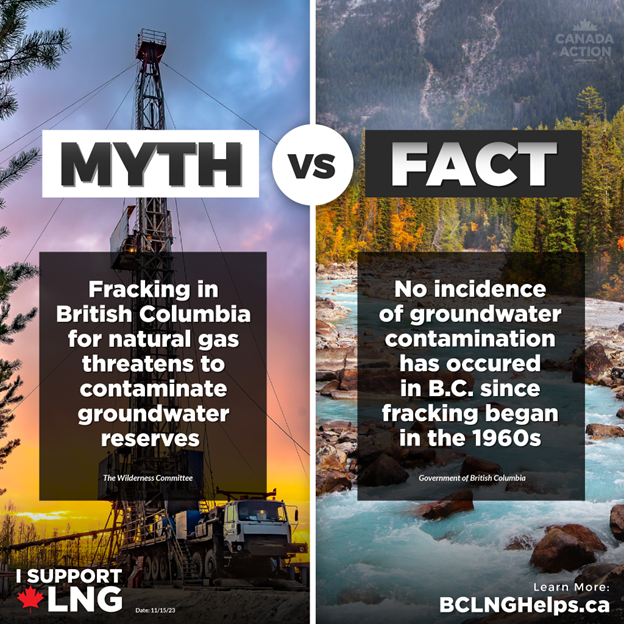
As liquefied natural gas (LNG) projects in British Columbia move forward through the construction and/or regulatory process, it is increasingly important we address a few myths surrounding these critical energy projects.
Here are three big myths on Canadian LNG projects you should know about, debunked!
MYTH #1 – Liquefied Natural Gas is “Not a Bridge Fuel”

FACT – The International Energy Agency (IEA) is one of many leading global organizations that have repeatedly said natural gas is a critical transition fuel on the path toward net zero.
“Natural gas is one of the mainstays of global energy. Where it replaces more polluting fuels, it improves air quality and limits emissions of carbon dioxide,” says IEA Executive Director Fatih Birol.
Natural gas emits up to 50 per cent less emissions than coal when used as an energy source, according to the International Governmental Panel on Climate Change (IPCC) [2].
But where’s the proof? Just look at the tangible emissions savings accomplished by coal-to-gas switching worldwide. For example:
- Since 2010, coal-to-gas switching has saved around 500 million tonnes of CO2– an effect equivalent to putting an extra 200 million EVs running on zero-carbon electricity on the road over the same period [1]
- Coal-to-gas switching in America’s power sector resulted in a CO2 emissions decline by more than 30 per cent between 2005 and 2019, despite the economy growing by 28 per cent [3]
- Electricity sector emissions in Alberta dropped nearly 50 per cent between 2015 and 2020, largely a result of coal-to-gas switching [4]
The climate action success of coal-to-gas switching is why many are pointing towards Canadian LNG as potentially having a major effect on lowering global emissions by displacing more GHG-intensive power plants overseas. LNG opponents can say whatever they want about coal-to-gas switching, but the proof is in the pudding.
MYTH #2 – Canadian LNG Will “Not Lower Global Emissions”

FACT – Environmental non-governmental organizations and their employees falsely claim that responsibly produced Canadian LNG – which is set to be some of the lowest emission liquified natural gas in the world – will not lower global emissions. The following studies suggest otherwise:
- Research by IHS Markit/S&P Global found that switching just 20 per cent of Asia’s coal-fired power plants to natural gas would reduce global CO2 emissions by an estimated 680 megatonnes (MT). For perspective, Canada’s annual emissions are 672 MT, meaning we would prevent an entire Canada’s worth of emissions from entering the atmosphere every year by displacing coal plants in Asia with responsibly produced B.C. LNG [5].
- A study in the Journal of Cleaner Production conducted three independent life-cycle assessments of switching from coal-to-gas for power and heat generation in the world’s second largest economy. The research groups from Stanford University, the University of British Columbia, and the University of Calgary found that substituting Canadian LNG for coal in China could accomplish up to a 62% reduction in CO2 emissions. The researchers signed a declaration of competing interest, confirming that they have no known competing financial interests or personal relationships that could have appeared to influence the work reported in this paper [6].
- Another academic study in Environmental Science and Technology conducted expansive research on the net impact of LNG on CO2 emissions for electricity generation in various Asian countries. The researchers found that significant GHG reductions could be achieved in China, India and Taiwan by displacing more intensive forms of fuel with LNG. Overall, the study suggests there is a significant benefit to the global environment by exporting Canadian LNG for use in Asia [7].
Anti-Canadian LNG activists claim there is little evidence of Asian countries wanting to displace coal-fired power plants with natural gas. But the reality is that global energy demand is growing, and we will need all forms to provide the world with the fuel it needs. China, for example, plans to double its LNG import capacity by 2025 [8] but also continue to rapidly expand its coal sector despite its climate commitments [13]. We must provide alternatives to coal whenever and wherever possible.
MYTH #3 – B.C. LNG is “Fracked and Dangerous”

FACT – LNG opponents regularly suggest that fracked gas – natural gas which is “hydraulically fractured” from formations deep underground in B.C. – is dangerous to public health, whether that be through groundwater contamination or leaky emissions. However, they fail to mention the world-class regulations in place to reduce methane venting and flaring volumes and other important geological facts. For example:
- Methane venting and flaring are strictly controlled in B.C. The provincial government has made significant efforts to eliminate it in natural gas operations, while routine flaring was eliminated in 2016 [9]. Even stricter methane regulations were introduced in 2020 which are designed to reduce emissions by 10.9 MT over a decade, equivalent to removing 390,000 cars off the road annually [10].
- The B.C. Energy Regulator conducts 4,000 to 5,000 inspections every year on oil and natural gas infrastructure, and if “leaky” methane emissions are found, companies are required by law to address them [10].
- B.C. reservoirs fracked to extract natural gas are found at depths ranging from 1,700 to 4,000 metres deep. This is far below where you’ll find potable water zones, which are typically anywhere from 18 to 150 metres deep. Hence, natural geological barriers prevent the migration of methane and hydraulic fracturing fluids into B.C.’s drinking water reserves [11].
- Drilling companies cannot drill within 200 metres of domestic water wells [11].
- Since hydraulic fracturing was introduced in B.C. in the 1960s, there have been zero incidences of groundwater contamination [11].
Environmentalists often point to NGO-funded studies suggesting that fracked natural gas in B.C. is unsafe for humans or the atmosphere. However, they fail to mention that these “reports” often refer to U.S. geologies and operations, which are far different than those found in B.C [12]. Conflating the two isn’t an honest interpretation of the facts.
The World Needs More Canadian LNG
Join us and hundreds of thousands of Canadians on X, Facebook and YouTube to learn more about our world-class natural resource sectors today!
SOURCES:
1 – https://www.iea.org/reports/the-role-of-gas-in-todays-energy-transitions
2 – https://www.ipcc.ch/site/assets/uploads/2018/03/srccs_chapter1-1.pdf
4 – https://www.cbc.ca/news/canada/calgary/road-ahead-alberta-coal-power-electricity-decline-1.5761858
5 – https://chamber.ca/wp-content/uploads/2023/04/Canada_and_Global_Energy_Security_March_2023.pdf
6 – https://www.sciencedirect.com/science/article/abs/pii/S0959652620307484
8 – https://shippingmatters.ca/china-to-double-its-lng-import-capacity/
9 – https://www.capp.ca/explore/flaring-and-venting/
10 – https://www.bc-er.ca/news-publications/trending-topics/methane-emissions/
11 – https://news.gov.bc.ca/factsheets/hydraulic-fracturing-in-british-columbia
13 – https://www.theguardian.com/world/2023/aug/29/china-coal-plants-climate-goals-carbon
Share This:




